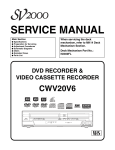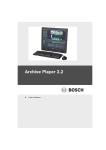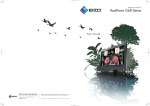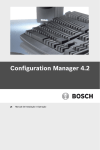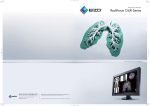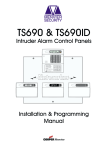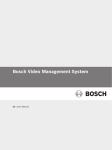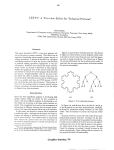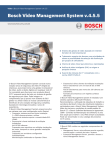Download Configuration Manager 5.0
Transcript
Configuration Manager 5.0 en Installation and operation manual Configuration Manager 5.0 Table of Contents | en 3 Table of contents 1 Using the Configuration Manager help 5 1.1 Finding information 5 1.2 Printing the Help 6 2 Introduction 7 2.1 About this manual 7 2.2 Conventions in this document 7 2.3 Additional documentation 7 3 System overview 8 3.1 Functions 4 Installation and starting 11 4.1 System requirements 12 4.2 Installation 14 4.3 Starting the program 14 4.4 Removing the program 15 5 User interface 16 5.1 Overview 16 5.2 The Menu bar 17 5.2.1 The File menu 17 5.2.2 The Tools menu 18 5.2.3 The Help menu 19 5.3 Toolbar tabs 20 5.3.1 The Devices tab 20 5.3.2 The My Devices tab 20 5.3.3 The Preferences tab 21 5.4 Toolbar icons 27 5.5 The Info bar 28 5.6 The Quick indication icons 28 5.7 The Status bar 29 5.8 The View pane 29 5.9 Used icons 31 5.10 Shortcut menu 32 5.11 Blocked input fields 35 Bosch Sicherheitssysteme GmbH 8 2014.02 | V2 | DOC 4 Configuration Manager 5.0 en | Table of Contents 6 Device configuration using Configuration Wizard 37 7 Working with Configuration Manager 39 7.1 Adding devices to the system 39 7.2 Allocating devices 39 7.2.1 Allocating listed devices 39 7.2.2 Allocating unlisted devices 40 7.3 Clearing device allocations 41 7.4 Creating groups 42 7.5 Accessing the device 43 7.6 Replacing devices 44 7.7 Saving screenshots, recordings and vbd.xml databases 46 7.8 Working offline 46 7.9 System emulation 49 7.10 Notes on multiple configuration 50 7.11 Configuring the toolbar 51 7.12 Obtaining device information 52 7.13 Disabling network scan 53 7.14 Working with Video Client 53 7.14.1 Creating users and user rights 54 7.14.2 Selecting components 55 7.14.3 Specifying access rights 55 7.15 Using Table view 56 7.16 Using Device Health Monitor 59 7.17 Device configuration using the View pane 60 7.18 Mapping replay clients using iqn-Mapper 61 7.19 Working with other components 63 7.19.1 IVA / IVMD 63 7.19.2 Video Client 63 7.19.3 VRM 63 7.19.4 Bosch VMS 63 7.19.5 Monitor Wall 64 Index 65 2014.02 | V2 | DOC Bosch Sicherheitssysteme GmbH Configuration Manager 5.0 1 Using the Configuration Manager help | en 5 Using the Configuration Manager help The online Help provides you with information about Configuration Manager directly on your screen. To find out more about how to do something in Configuration Manager, access the online Help using any of the following methods. To use the Contents, Index, or Search: 4 On the Help menu, click Online Help.... Use the buttons and links to navigate. To get Help on a window or dialog (if available): 4 1.1 On the toolbar, click . Finding information You can find information in the Help in several ways. To find information in the Online Help: 1. On the Help menu, click Online Help..... 2. If the left-hand pane is not visible, click the Show button. 3. In the Help window, do the following: Contents Display the table of contents for the Online Help. Click each book to display pages that link to topics, and click each page to display the corresponding topic in the right-hand pane. Index Search for specific words or phrases or select from a list of index keywords. Double-click the keyword to display the corresponding topic in the right-hand pane. Search Locate words or phrases within the content of your topics. Type the word or phrase in the text field, press ENTER, and select the topic you want from the list of topics. Bosch Sicherheitssysteme GmbH 2014.02 | V2 | DOC 6 Configuration Manager 5.0 en | Using the Configuration Manager help Notice! Texts of the user interface are marked bold. 4 The arrow invites you to click on the underlined text or to click an item in the application. Related Topics 4 Click to display a topic with information on the application window you currently use. This topic provides information on the application window controls. 1.2 Printing the Help While using the Online Help, you can print topics and information right from the browser window. To print a Help topic: 1. Right-click in the right pane and select Print. The Print dialog box opens. 2. 2014.02 | V2 | DOC Click Print. The topic is printed to the specified printer. Bosch Sicherheitssysteme GmbH Configuration Manager 5.0 2 Introduction 2.1 About this manual Introduction | en 7 This manual is intended for persons responsible for configuring and managing a CCTV system. This manual describes how to use the Configuration Manager program. This document assumes that the reader is familiar with both the CCTV system and the other programs that are integrated into the system. 2.2 Conventions in this document In this document, the following symbols and notations are used to draw attention to special situations: Notice! This symbol indicates special features and provides tips and information for easier, more convenient use of the software. Terms that you can find in the program, such as menu options or commands, are written in bold. 2.3 Additional documentation Once the Configuration Manager program has been installed, this document is also available as online Help within the program. Documentation for Bosch Security System products can be found as follows: 4 www.boschsecurity.com > select your region and your country > select Product Catalog > start a search for your product > select the product in the search results to show the existing documents. Bosch Sicherheitssysteme GmbH 2014.02 | V2 | DOC 8 3 Configuration Manager 5.0 en | System overview System overview Configuration Manager program is used to configure all IP devices and components in your CCTV network. With Configuration Manager you have access to all devices and software components. The program offers also a configuration wizard for quick basic configuration of devices. However, you can also carry out the further configuration with the normal user interface. 3.1 Functions Configuration Manager provides the following functions (the availability of these depends on the environment in which the program is used): – Network Scan The network scan is performed automatically every time Configuration Manager starts, and is repeated at regular intervals. This function automatically detects all compatible devices present in a network, such as cameras or video senders, video receivers or VRM. The status of a device is also queried in each scan and then indicated by the icons in front of the devices. – Device information and configuration Comparable with the Web browser view, Configuration Manager shows the current configuration for each device and allows you to change the settings. – Device system integration You use the Device allocator in Configuration Manager to make devices accessible for use with Video Client. – Configuration Wizard A Configuration Wizard helps you to configure all devices for basic operation in just a few steps, even for extensive systems. 2014.02 | V2 | DOC Bosch Sicherheitssysteme GmbH Configuration Manager 5.0 – System overview | en 9 Multiple configuration You can use Configuration Manager to make individual settings for multiple devices simultaneously (for example, time settings), allowing you to configure large systems more quickly. – Simpler access to devices The Screenshot Scan function gives an overview of all the cameras that provide video data. The screenshots can be used to identify the camera and device, and give you direct access to said camera or device. – Table View This allows you to compile specific parameter settings for selected devices. This provides you with a quick overview of the settings that are of interest to you and allows you to export this information for archiving at the push of a button. – Device Health Monitor This provides you with a quick overview of the status of selected devices, such as the encoder load and type of network connection. – Work Offline Configuration Manager allows you to make settings for selected devices offline. When in operation, the configuration data of the devices is transferred to your computer where it can be edited offline. This functionality can also be used to back up the configuration data of the devices locally. If, for example, a device needs to be replaced by another of the same type, this data can then be transferred to the new device. This functionality is extended with the Replacement command. Replaced devices are detected and automatic configuration is possible thanks to the saved data. Bosch Sicherheitssysteme GmbH 2014.02 | V2 | DOC 10 en | System overview – Configuration Manager 5.0 System emulation The complete system configuration can be saved as a system image and emulated using a different Configuration Manager application. This function helps you to isolate problems without having to access the actual system. – Access to license management Firmware modules requiring a license, such as IVA (Intelligent Video Analysis), are set up using Configuration Manager. 2014.02 | V2 | DOC Bosch Sicherheitssysteme GmbH Configuration Manager 5.0 4 Installation and starting | en 11 Installation and starting Configuration Manager is automatically part of the installation for all video IP devices from Bosch that require Configuration Manager for configuration purposes. Furthermore, you can also use Configuration Manager to simplify the configuration in a CCTV system with many similar video senders. Bosch Sicherheitssysteme GmbH 2014.02 | V2 | DOC 12 4.1 Configuration Manager 5.0 en | Installation and starting System requirements Operating system – Windows XP SP3 (32 bit), .NET – Windows 7 SP1 (32 bit, 64 bit in Framework 3.5 required 32 bit emulation mode), .NET Framework 3.5 required – Windows 8 (32 bit, 64 bit in 32 bit emulation mode), .NET Framework 3.5 required Supported graphic NVIDIA Quadro 600 card NVIDIA Quadro 2000 NVIDIA Quadro 5000 NVIDIA Quadro FX 580 NVIDIA Quadro FX 1400 NVIDIA Quadro FX 1500 NVIDIA Quadro FX 1700 NVIDIA Quadro FX 1800 NVIDIA Quadro FX 3500 NVIDIA Quadro FX 3700 NVIDIA Quadro FX 3800 NVIDIA Quadro FX 4000 NVIDIA Quadro FX 4600 NVIDIA Quadro FX 4700 NVIDIA Quadro FX 4800 NVIDIA Quadro Fermi 2000 NVIDIA Quadro Fermi 4000 NVIDIA NVS 295 NVIDIA NVS 440 NVIDIA NVS 450 NVIDIA GT 520 ATI FirePro V2460 ATI FirePro V3700 ATI FirePro V3800 ATI FirePro V3900 2014.02 | V2 | DOC Bosch Sicherheitssysteme GmbH Configuration Manager 5.0 Installation and starting | en 13 ATI FirePro V4800 ATI FirePro V4900 ATI FirePro V5700 ATI FirePro V5800 ATI FirePro V5900 ATI FirePro V7900 ATI FirePro V8800 ATI FireGL V5600 ATI FirePro V7200 Graphic cards that are not listed here must be at least fully compatible to DirectX 9. Onboard graphic All with first generation of Intel Core i- adapter series. Sound card Recommended Network adapter 100 Mbps Notice! All Microsoft updates and hotfixes must be installed on target PCs. Graphic card drivers must also have the latest officially released version. Bosch Sicherheitssysteme GmbH 2014.02 | V2 | DOC 14 4.2 Configuration Manager 5.0 en | Installation and starting Installation You can install Configuration Manager on as many computers running Microsoft Windows as you wish. To install Configuration Manager: 1. Close all other applications before beginning the installation. 2. Download the software package. 3. Select the extraction directory and double-click Setup_ConfigManager.exe. The Configuration Manager wizard dialog box is displayed. 4. On the Welcome dialog box, click Next. 5. In the Select components to install: list, select the respective tools, then click Next. 6. In the Choose Install Location dialog box, select the destination folder, then click Install. The installation process starts. Note: We recommend using the default destination folder. 7. 4.3 Click Finish. Starting the program After successful installation, you will find the following icon on your desktop: To start the program: 4 Double click this icon. or 4 On the Start menu, click Configuration Manager. Note: Several video IP devices from Bosch enable you to start Configuration Manager directly within the relevant program. 2014.02 | V2 | DOC Bosch Sicherheitssysteme GmbH Configuration Manager 5.0 Installation and starting | en 15 Operation of Configuration Manager varies according to the context in which it is being used. In some cases, it is merely a tool that enables you to configure video IP devices from Bosch more conveniently and more comprehensively. For certain programs and firmware modules, however, Configuration Manager is indispensable, as it is the only way to set these up. 4.4 Removing the program If you no longer wish to use the program on your computer, you can remove the program at any time. To remove the program: 1. Click Start, click Settings, then click Control Panel. 2. Double-click Add or Remove Programs. 3. Select the Configuration Manager entry. 4. Click Remove. Bosch Sicherheitssysteme GmbH 2014.02 | V2 | DOC 16 5 Configuration Manager 5.0 en | User interface User interface In this section, you will find detailed information about the user interface. 5.1 Overview 2 1 6 7 3 4 8 1 Menu bar 2 Toolbar tabs 5 9 For quick access (Devices, My Devices, Preferences) 3 Toolbar icons For quick access (configurable). 4 Info bar With name, type and IP address of the selected device. 5 Quick indication icons Displays CPU load, network and recording status. 2014.02 | V2 | DOC Bosch Sicherheitssysteme GmbH Configuration Manager 5.0 User interface | en 6 Device tree structure with filter option. 7 Additional functions, for example, Refresh 8 Status bar 9 View pane 17 Depending on the toolbar tab selected, this window displays different device tabs with configuration options and information. 5.2 The Menu bar This section contains special operational functions, tools and help functions. 5.2.1 The File menu To obtain the menu commands: 4 Click the File menu. The following commands are displayed. Connect to Server... Connects Configuration Manager to a server. This allows you to set up a server and configure a client/server system. Disconnect from Server The connection between Configuration Manager and a server is broken. Work Offline / Work Online The settings for selected devices can be made offline while the device remains in operation. For this purpose, the configuration files of the devices are backed up locally on your computer. You can edit the data and send it back to the devices at a later stage. Emulate Alien System... / Abandon Emulation Imports the system image of an alien Configuration Manager system. Bosch Sicherheitssysteme GmbH 2014.02 | V2 | DOC 18 en | User interface Configuration Manager 5.0 Close The Configuration Manager program is closed. This also breaks the connection between Configuration Manager and the server. 5.2.2 The Tools menu To obtain the menu commands: 4 Click the Tools menu. The following commands are displayed. Configuration Wizard... Starts the wizard for the basic configuration of devices. Logging... Displays the Device Communication Log dialog box. Here, you can view the RCP+ commands that are transmitted by Configuration Manager when connecting to devices, if you have enabled logging. Device Allocator... Displays the Device Allocator dialog box. An overview of all available devices in the network and all devices that are allocated to the system. Table View... Displays the Devices Table View dialog box. A summary of specific settings for individually selected devices. Screenshot Scan... Displays a window in which a screenshot for each of the connected cameras is displayed. If you right-click a screenshots, the commands are displayed relevant for the device. Device Health Monitor... Displays the Device Health Monitor dialog box, which provides a quick overview of the status of selected devices. Save System Image Saves the image of the currentConfiguration Manager system for emulation on a different PC. 2014.02 | V2 | DOC Bosch Sicherheitssysteme GmbH Configuration Manager 5.0 User interface | en 19 iqn-Mapper... Displays the iqn-Mapper dialog box, in which you can map replay clients to NetApp iSCSI systems. Others Other software components can be started directly. The prerequisite for this is that the relevant program is installed on the same PC. 5.2.3 The Help menu To obtain the menu commands: 4 Click the Help menu. The following commands are displayed. Online Help... Displays the Configuration Manager online Help. Online Help VRM... Displays the Video Recording Manager online Help. About... Displays the About Configuration Manager dialog box, containing information on, for example, the software components installed on this PC and the software version numbers of the installed components. Bosch Sicherheitssysteme GmbH 2014.02 | V2 | DOC 20 en | User interface 5.3 Configuration Manager 5.0 Toolbar tabs The toolbar enables quick access to the most important functions. 5.3.1 The Devices tab This tab shows all video IP devices supported by Configuration Manager that are detected in the network scan. Additional Information: – The information about a device is shown in bold if the device is newly detected since the last network scan. – The information about a device is shown in red if the device has an IP address or a MAC address that is already used by another device in the system. This might be the case, for example, if several devices that have not yet been configured are connected directly after one another. – Additional information about the devices can be seen if you scroll to the right. 5.3.2 The My Devices tab This tab shows all devices that have previously been manually allocated to the system. Additional Information: – The information about a device is shown in bold if the device is newly detected since the last network scan. – The information about a device is shown in red if the device has an IP address or a MAC address that is already used by another device in the system. This might be the case, for example, if several devices that have not yet been configured are connected directly after one another. – Additional information about the devices can be seen if you scroll to the right. 2014.02 | V2 | DOC Bosch Sicherheitssysteme GmbH Configuration Manager 5.0 5.3.3 User interface | en 21 The Preferences tab This tab enables you to access general and application-specific settings. Here, you can carry out a basic configuration for Configuration Manager itself as well as for other video IP devices from Bosch. This tab has a tree structure with the following main folders: – General – Applications If necessary, expand the folders to obtain subordinate items. General folder In this tab you make the settings that affect several programs. Changes only become active if you click the Save icon on the toolbar. – General > Directories Specifies where screenshots, recording sequences and vdb.xml databases should be saved. These settings are relevant for Video Client. – General > Logging Enable or disable the logging of RCP+ commands. A log file is created for every device in the system. You can also specify the minimum period for which you want the log data to be saved. – General > Client/Server – Access tab > Server group Connect to server Enable this option if you manage your system with VRM. For details, refer to the separate VRM documentation. Server IP address Enter the IP address of the computer on which VRM has been started. IP address failover server 1 IP address failover server 2 Bosch Sicherheitssysteme GmbH 2014.02 | V2 | DOC 22 Configuration Manager 5.0 en | User interface If necessary, enter the IP addresses of the failover server computers. – iSCSI Media tab > iSCSI Media group Password Enter the password for accessing the iSCSI media, if these are password-protected. When assigning passwords, please note that they must be valid for the entire system. Applications folder In this tab you make the settings that affect an individual program. When leaving this page Configuration Manager asks you whether you want to save the changes. Changes only become active if you click the Save icon on the toolbar. Only programs that are installed on your computer are listed under this tab. If a program is not listed under this tab, check if it is installed on your computer and install it if necessary. – Applications > Configuration Manager This is where you can change the default settings for Configuration Manager. – Access tab > Access group Password Assign a password here that protects access to Configuration Manager. If you do not enter anything in this field, the program will start without asking for a password. This password is only valid for the computer on which it was defined. – Network Scan tab > Network Scan group Run continuous network scan Enable this option if the network is to be scanned at regular intervals. Scan interval [s] Enter the time interval in seconds for automatic scanning here, choosing a value between 10 and 3600 seconds (1 hour). 2014.02 | V2 | DOC Bosch Sicherheitssysteme GmbH Configuration Manager 5.0 User interface | en 23 Use Multicast If you are using devices in various subnets, activate this option. This allows all devices that belong to a different subnet than the PC on which Configuration Manager is installed to also be included in the network scan. Otherwise you will have to manually add these devices to the system. Multicast operation requires a multicast-enabled network that uses the UDP and the Internet Group Management IGMP protocols. – Network Scan tab > IP address range group Mode Specify the IP address ranges and expressly permit or prohibit the use of these addresses. – Video tab > Monitor group Refresh interval Select how often the screenshots that are shown in the various tabs (e.g. VCA) are refreshed: Continuous: Image is refreshed as often as possible. 0 seconds: Image is displayed once but not refreshed. 1 … 10 seconds: Image is refreshed accordingly. Encoder Select whether the images should be displayed in video format (MPEG) or as constantly updated screenshots (JPEG). – Repository tab > Repository group Database folder Select the path to the folder for offline configuration. If you do not enter anything here, the following default setting is used. – Logging tab > Device I/O group Select whether the device communication log should be wrtten in a file and which data it should include. – Appearance tab > Startup group Restore last view Bosch Sicherheitssysteme GmbH 2014.02 | V2 | DOC 24 Configuration Manager 5.0 en | User interface If enabled, the view last used is displayed when Configuration Manager is next started. After confirmation only If enabled, the next time you start Configuration Manager you will be asked whether you want to restore the last view used. – Appearance tab > View group Show ONVIF devices (experimental) If enabled, all ONVIF devices are displayed. – Appearance tab > Toolbar group Main toolbar Click Edit to adapt the toolbar. – Appearance tab > Database camera name group Prefix device name to camera name Displays the encoder device name before the camera name in the camera list if cameras are integrated into the system over video encoders. – Applications > Video Client This is where you can change the settings of Video Client. – User Management tab > Management tab Users group Implement user administration to control access to the Video Client program. – Cameras tab > Camera Order tab Camera order group Define which cameras are listed in Video Client and define corresponding access rights. – Cameras tab > Camera Access tab Camera access group Specify the access rights for the cameras listed in Video Client. Each user is assigned the highest authorization level by default. – Digital Inputs tab > Digital Input Order tab Digital input order group 2014.02 | V2 | DOC Bosch Sicherheitssysteme GmbH Configuration Manager 5.0 User interface | en 25 Define which digital inputs are listed in Video Client and define corresponding access rights. – Digital Inputs tab > Digital Input Access Digital input access group Specify the access rights for the digital inputs listed in Video Client. Each user is assigned the highest authorization level by default. – Alarm Outputs tab > Output Order tab Output order group Define which alarm outputs are listed in Video Client and define corresponding access rights. – Alarm Outputs tab > Output Access Output access group Specify the access rights for the alarm outputs listed in Video Client. Each user is assigned the highest authorization level by default. – Application tab > Application tab > Workstation recording group Path for workstation recording Select the path to the folder to which Video Client will export manual recordings. If you do not enter anything here, the following default setting is used: %current user%\My Documents\ Bosch\VideoClient \Recording Maximum disk usage [GB] Define the maximum hard disk memory to be used for manual recordings. If you do not enter anything here, the default setting 10 is used. Delete recordings when maximum disk usage exceeded Activate this option if existing recordings are to be overwritten when the specified maximum memory capacity has been reached. – Application tab > Application tab > IntuiKey group Bosch Sicherheitssysteme GmbH 2014.02 | V2 | DOC 26 Configuration Manager 5.0 en | User interface Use keyboard Select the checkbox if a Intui Keyboard is used. COM port If the program is operated via an IntuiKey control panel, enter the number of the COM port here. – Application tab > License tab On this page you can find information on the licensing of camera channels in Video Client. A Video Client installation has 16 camera channels as standard. You can enable additional channels by purchasing a license. For more information, please see the Video Client operator’s manual. Host-ID The host ID, which is needed to install a license for additional camera channels for Video Client, is displayed here. Number of cameras The number of enabled camera channels is displayed here. Add License... Click to add a license file for additional camera channels. The Add License File. 2014.02 | V2 | DOC Bosch Sicherheitssysteme GmbH Configuration Manager 5.0 5.4 User interface | en 27 Toolbar icons The toolbar icons allow quick access to several Configuration Manager functions. Reload page Reloads the page for the selected device. Info Displays detailed information about the selected device. Live video Displays the live video data from the selected device. Logging Displays the Device Communication Log dialog box. Here, you can view the RCP+ commands that are transmitted by Configuration Manager when connecting to devices, if you have enabled logging. Device allocator Displays the Device Allocator dialog box. This dialog box allows you to allocate devices to the system and build the device tree structure. Table view Displays the Table View dialog box. Save Saves any settings that have been configured for the selected device. Bosch Sicherheitssysteme GmbH 2014.02 | V2 | DOC 28 5.5 Configuration Manager 5.0 en | User interface The Info bar When one of the Devices or My Devices tabs is selected, an info bar is displayed above the View pane. This info bar provides you with brief information about each selected device as follows: – Device name – Device type – Device IP address Note: If several devices are selected, all fields contain the entry <Multiple> For hardware devices, you can use the icons on the right-hand edge of the bar to display additional information. 5.6 The Quick indication icons To display the quick indication icons: 4 Drag the pointer on the icons to view details on the processor load, network connection and recording status: Quick indication icon description – The left icon indicates the proportions of the individual functions on the encoder load, shown as percentages. For devices with two processors, a separate icon is shown for each processor. – The icon in the middle indicates the network connection type and the speed of the outgoing (UL = Uplink) and incoming (DL = Downlink) data traffic. – The right icon indicates information on the recording status. – Green: active recording – Red: error – Orange: recording scheduler active, no current recordings – Gray: recording scheduler not active, no current recordings 2014.02 | V2 | DOC Bosch Sicherheitssysteme GmbH Configuration Manager 5.0 5.7 User interface | en 29 The Status bar The status bar at the bottom edge of the window shows the following: – In the left section: whether or not a network scan is currently in progress. – In the central section: the number of detected, visible and selected devices. – In the right section: whether you are currently working Online or Offline, and whether or not Configuration Manager is currently connected to a server. If it is connected to a server, the server IP address is displayed. Otherwise the entry DB local appears here. If you are emulating an alien system, the entry System emulation appears here. – On the far right: the version number of Configuration Manager is displayed. 5.8 The View pane The View pane for the Devices and My Devices tabs shows a series of subdivided tabs, the number and content of which depend on the device selected in the list. The tabs in the View pane can be used to make the configuration settings that the device also provides in the Web browser view, some of them with a slightly different composition. Access from Configuration Manager to the devices can be configured when selecting the General and Unit Access tab (not necessary for web browser). Detailed information about the configuration options for a device can be found in the relevant device documentation and the online Help in the relevant Web browser view. Bosch Sicherheitssysteme GmbH 2014.02 | V2 | DOC 30 en | User interface Configuration Manager 5.0 Notice! Changes only become active if you click the Save icon on the toolbar. 2014.02 | V2 | DOC Bosch Sicherheitssysteme GmbH Configuration Manager 5.0 5.9 User interface | en 31 Used icons The devices in the Devices / My Devices tabs are represented by the following icons: Device icons Encoder/Decoder Camera Hardware recorder Storage system iSCSI target Drive VRM server VRM failover server VRM server for second recording stream VRM failover server for second recording stream Device status icons The status of a device is represented as follows: Device is online. Device is offline. Devices that are displayed dimmed are unattainable. No communication is possible. For example, these could be devices for which the power supply has been interrupted. Device is faulty. A red icon with an exclamation point indicates devices that are faulty. Bosch Sicherheitssysteme GmbH 2014.02 | V2 | DOC 32 Configuration Manager 5.0 en | User interface Device is password-protected. Devices that are protected by a password are indicated by a padlock until you have authenticated yourself for the device. Device is offline and password-protected. This devices are displayed dimmed and indicated by a padlock. 5.10 Shortcut menu Right-click a device to open the shortcut menu. If you have selected multiple devices, not all options in the shortcut menu are enabled. The following provides an overview of the commands: Add to System... (Devices tab) Allocates the selected device to the system. Before making an allocation, you can select a group or create a new one. This command corresponds to the Device Allocator dialog box. Select Group (My Devices tab) If several devices have been grouped, use this command to select all devices or cameras of that group for editing. New Device... (My Devices tab) Allocates a non-listed device to the system. This command is only active if you click the area in the left pane in which no devices are listed. Delete (My Devices) Deletes the selected device from the system. 2014.02 | V2 | DOC Bosch Sicherheitssysteme GmbH Configuration Manager 5.0 User interface | en 33 Set Session Authentication... (Devices tab) If a selected device is protected by a password, you must authenticate yourself for that device. Configure... Displays the respective configuration tool if installed. Add iSCSI System... (VRM) Displays the Add iSCSI System dialog box. Here, you can add an iSCSI system to the VRM using the host IP address and the SNMP IP address. LUN Assignment... (iSCSI system) Displays the LUN Assignment dialog box. Here, you can add individual LUNs to the system. File Upload – Firmware... You can select the desired upload file and start the upload. Refer to the information about firmware uploads in the documentation for the relevant device. You can use this command to carry out a firmware upload for several devices at the same time. You must ensure that all selected devices are of the same device type when you carry out a firmware upload for several devices at the same time. – SSL Certificate... Upload an SSL certificate to the device to enable encrypted communication with the device. – Decoder Logo... The decoder logo is the image displayed by the decoder if there is no connection to a device. You can upload your own logo for this purpose. This must be in H.263 format. Bosch Sicherheitssysteme GmbH 2014.02 | V2 | DOC 34 Configuration Manager 5.0 en | User interface Settings (Add to System... and My Devices tab) – Download... Configuration data of the selected devices is saved on your computer for offline editing. – Upload... The configuration data that was edited offline is sent to the selected device. Once the upload has been successfully completed, the device operates according to the new configuration data. – Replacement... (only in My Devices tab) Configuration data of replaced devices is automatically replaced with locally stored data of a device of the same type. Device Network Settings... (Add to System... and My Devices tab) You will see the Network settings dialog box. This dialog box is used to change the IP address, subnet mask and gateway of the selected device or activate automatic IP assignment via DHCP. This is only possible for devices that are not passwordprotected. Show Live Video... (Add to System... and My Devices tab) A window opens, displaying the live video data from the selected device. You are offered different display options depending on which device you selected. Show in Web Browser... (Add to System... and My Devices tab) The livepage of the Web browser view for the device is opened in the default browser. Show Settings in Web Browser... The configuration page of the Web browser view for the device is opened in the default browser. 2014.02 | V2 | DOC Bosch Sicherheitssysteme GmbH Configuration Manager 5.0 User interface | en 35 Device Info... The dialog box containing device information is displayed. Blink LED (Add to System... and My Devices tab) A LED on the device flashes. This allows you to check whether there is any communication between Configuration Manager and the device. This command also helps you to identify a device if several devices of the same type are installed at the same location. Restart (Add to System... and My Devices tab) Initiates a reboot of the device. This is only possible for devices that are not password-protected. Ping (Add to System... and My Devices tab) Pings the selected device to confirm network communication with the device. 5.11 Blocked input fields It is possible that some fields are blocked for editing. The causes for the block are indicated by different entries in the fields. If several devices are selected, some settings cannot be made. The input fields are marked with a padlock. If a device is currently recording, some settings cannot be modified. The input fields are marked with a padlock. If necessary, stop the recording. Bosch Sicherheitssysteme GmbH 2014.02 | V2 | DOC 36 Configuration Manager 5.0 en | User interface If there is a configuration error, individual fields are marked accordingly. This icon is also displayed if the device is offline and you attempt to load or save settings. Input fields you are not authorized to change are marked by a padlock and are blocked for editing. Some input fields cannot be edited when you are working offline (date and time settings). 2014.02 | V2 | DOC Bosch Sicherheitssysteme GmbH Configuration Manager 5.0 6 Device configuration using Configuration Wizard | en 37 Device configuration using Configuration Wizard Configuration Wizard helps you to configure devices in the network quickly and conveniently for basic operation. Using Configuration Wizard: 1. In the Tools menu, click Configuration Wizard..., then click Next >. The Configuration Wizard dialog box is displayed. The wizard guides you through the configuration process. 2. Passwords You have the option of assigning universal, system-wide passwords for the three specified user groups. If you do not wish to do this, leave the input fields empty. The passwords for the system user accounts are mapped to the system components. When accessing a device, the following passwords are used: administrator is used for access level service operator is used for access level user. Also observe the authorization levels: – Authorization levels of Configuration Manager: (highest / medium / lowest) administrator / operator / live – Authorization levels of video devices: (highest / medium / lowest) service / user / live 3. Recorder Select whether to record locally on the devices (e.g. to an SD card) or using a recorder. When using a recorder, enter the relevant IP address or select the address of a configured recorder from the list. 4. Device Selection All devices detected in the network are listed. Select the devices you want to configure with the wizard. Bosch Sicherheitssysteme GmbH 2014.02 | V2 | DOC 38 en | Device configuration using Configuration Wizard Configuration Manager 5.0 Note: Not all devices support IP address configuration via DHCP. If required, click Update to configure these devices manually at a later stage. 5. Network Activate the Use DHCP option if all devices support DHCP and you want to assign IP addresses automatically in this way. Alternatively, enter an IP address range. This must provide sufficient IP addresses for all the devices to be configured. 6. Date and Time Select whether the date and time are to be taken from the settings on your PC or from an SNTP server. If necessary, reset the system time and date on your PC or enter the IP address of an SNTP server. 7. Video Quality Specify the quality of the video data for all devices. The relevant settings for each device are made automatically. 8. Recording Create a uniform recording scheduler for all devices. If no recordings are to be scheduled, you must select Off mode for every recording profile. 9. Summary A summary of the selected settings is displayed. Click Apply to configure the devices according to the selected settings. 2014.02 | V2 | DOC Bosch Sicherheitssysteme GmbH Configuration Manager 5.0 7 Working with Configuration Manager | en 39 Working with Configuration Manager The following section offers a list of user actions for configuring hardware and software components that can be performed using Configuration Manager. 7.1 Adding devices to the system You can add devices and components to the system that are detected in the network. To add devices to the system: 1. On the toolbar, click the Devices tab, right-click a device in the tree structure, then click Add to System.... The Add Device to System dialog box is displayed. 2. Select an existing group to assign the device or leave the field empty if you do not want to assign the device to a group. 3. Click OK. See also: – 7.2 Allocating devices, page 39 Allocating devices Before working with Video Client, you must complete the allocation, as the program can only access devices that have been allocated to the system. 7.2.1 Allocating listed devices You can allocate all devices using the Devices tab. It is also possible to allocate devices to the system by adding them to the My Devices tab. This simplifies configuration as you can limit yourself to a relevant selection of available devices and clearly arrange the allocated devices in groups. To allocate listed devices using the Device Allocator icon: Bosch Sicherheitssysteme GmbH 2014.02 | V2 | DOC 40 Configuration Manager 5.0 en | Working with Configuration Manager 1. On the toolbar, click the Device Allocator icon. The Device Allocator dialog box is displayed. All devices detected in the network are displayed on the left-hand side of the dialog box, while those allocated to the system appear on the right. 2. Drag the unallocated devices from the left to the right-hand side of the window. 3. If necessary, sort the list of entries. To do this, click the appropriate table header. 4. Click OK. The devices are integrated into the system. Notice! If it is not possible to integrate a device, a warning message appears. See also: – 7.2.2 Creating groups, page 42 Allocating unlisted devices The Device Allocator dialog box also enables you to allocate devices to the system that were not detected during the network scan. Allocating an unlisted device: 1. In the Device Allocator dialog box, right-click into the Allocated devices area (but not on a device). 2. Click New Device.... The Device Editor dialog box is displayed. 3. Enter the URL (for example, the IP address with the port number) of the device. The IP address must previously have been set on the device. 4. In the Type list, select <Auto detect> or select the device type from the list of supported devices. If you select an ISDN-compatible device, the field for the telephone number is also activated. 2014.02 | V2 | DOC Bosch Sicherheitssysteme GmbH Configuration Manager 5.0 5. Working with Configuration Manager | en 41 Enter the telephone number for the ISDN connection if you want a device to be connected using an ISDN line. 6. Click OK. The device is listed as allocated device. Notice! You can only allocate supported devices. In the tree structure of the Devices and My Devices tabs, not supported devices are displayed dimmed or red. See also: 7.3 – Creating groups, page 42 – Used icons, page 31 Clearing device allocations You can remove devices from the system at any time by clearing the allocation. The devices are then no longer listed in the My Devices tab and can no longer be accessed in Video Client. To clear device allocations: 1. On the toolbar, click the Device Allocator icon. The Device Allocator dialog box is displayed. 2. Drag a device from the right to the left-hand side of the dialog box or right-click the device and click Delete. 3. Click OK. Notice! Delete groups in the same way. If you delete a group, you also clear the allocation of all devices that you have allocated to that group. Bosch Sicherheitssysteme GmbH 2014.02 | V2 | DOC 42 en | Working with Configuration Manager 7.4 Creating groups Configuration Manager 5.0 The Device Allocator dialog box enables you to clearly combine the devices into groups, for example sorted by locations. To create groups: 1. In the Device Allocator dialog box, right-click into the Allocated devices area (but not on a device). 2. Click New Group.... The Add New Group dialog box is displayed. 3. Enter a name for the new group. 4. Click OK. The group is added to the list. 5. Drag a device from the list to the group name. The device is added to the group and listed under the corresponding name. Note: To remove a device from a group, drag the device from the group to the list. 6. Click OK. The grouping is displayed in the device tree structure. You can also create sub-groups by dragging a group to the name of another group in the Device Allocator dialog box. Additional Options – On the toolbar, click the My Devices tab, right-click the tree structure area (but not on device), then click New Device.... – On the toolbar, click the Devices tab, right-click a device in the tree structure, then click Add to System.... A dialog box is displayed, in which you can assign the device to a group. Select an existing group to assign the device or leave the field empty if you do not want to assign the device to a group. 2014.02 | V2 | DOC Bosch Sicherheitssysteme GmbH Configuration Manager 5.0 7.5 Working with Configuration Manager | en 43 Accessing the device If a device is not currently communicating with the system, for example, because it is only temporarily contactable or because a firewall is blocking communication, a message is displayed in the view window. In this case, Configuration Manager offers various setting options to enable communication again. IP address failure Communication can fail because the device IP address has been changed (for example, using the device's Web browser view) and Configuration Manager is still using the old IP address to establish the connection. 1. On the toolbar, click the Devices tab. 2. Click Refresh (below the tree structure). Configuration Manager scans the network for devices and displays them with their current settings. Device Access If a firewall is blocking communication between the device andConfiguration Manager, you can change the transmission protocol: 1. On the toolbar, click the My Devices tab, click the General tab, then click the Unit Access tab. 2. In the Device access group, select the transmission protocol from the Protocol list. – Standard – HTTP UDP transmission via unspecified port TCP transmission via preset port – HTTPS TCP transmission via preset port 3. If you have selected HTTP or HTTPS as the protocol, you must set the port to correspond to the settings stored in the device. Bosch Sicherheitssysteme GmbH 2014.02 | V2 | DOC 44 Configuration Manager 5.0 en | Working with Configuration Manager 4. Under Authentication, you can set up a password for a user name of the relevant device. This means that Configuration Manager automatically has access to the device when establishing a connection without the password protection having to be disabled each time. Notice! Do not use any special characters, for example &, in the password. Special characters are not supported for the password and can prevent you from being able to access the program. 7.6 Replacing devices If devices must be replaced, most of the configuration for the new devices can be done automatically using the Replacement function. The Replacement function can only be used on devices that are allocated to the system – such devices are listed in the My Devices tab. To replace devices: 1. On the toolbar, click the Preferences tab, expand Applications in the tree structure, click Configuration Manager, then click the Repository tab. 2. In the Database folder box, enter the location in which configuration data is to be backed up. 3. On the toolbar, click the My Devices tab, right-click the device, click Settings, then click Download.... The device configuration settings are saved locally on your PC. 4. Replace the device. 5. In Configuration Manager, click the My Devices tab. The replaced device is shown as not being configured. 2014.02 | V2 | DOC Bosch Sicherheitssysteme GmbH Configuration Manager 5.0 6. Working with Configuration Manager | en 45 Right-click the device, click Settings, then click Replacement.... The Device Replacement Wizard dialog box lists all devices that are the same type as the replaced device and for which configuration data is saved. 7. Select the replacement device that was installed instead of the selected device. 8. Click Next >. Automatic configuration is started. 9. You will be informed if the firmware version of the device and the configuration file differ. You are able to download a new firmware version onto the device. 10. Click Next > again. The Device Replacement dialog box is displayed, listing the selected device and additional information. 11. Click Start. The configuration files are transferred. If it is not possible to transfer all the data, the number of data packets not transferred is listed in the Failed column. Once the transfer is complete the device is rebooted so that the new settings take effect. When the Cancel button is replaced by the Close button, the procedure is complete. 12. Click Close. The Device Replacement Wizard dialog box is displayed again. 13. Click Finished to complete the procedure. Bosch Sicherheitssysteme GmbH 2014.02 | V2 | DOC 46 Configuration Manager 5.0 en | Working with Configuration Manager 7.7 Saving screenshots, recordings and vbd.xml databases Specify where screenshots, recording sequences and vdb.xml databases should be saved. These settings are relevant for Video Client. To save screenshots, recordings and vbd.xml databases: 1. On the toolbar, click the Preferences tab, expand General in the tree structure, click Directories, then click the Directories tab. 2. In the relevant input field, enter the path for the storage location or click … to select a folder. You can select any directory that is available in the network as the target location. If you do not enter a screenshot folder and a recording folder, the following default setting is used: – C:\New Folder Warning! ! 7.8 Check the selected directories regularly for available storage capacity. Delete recordings that are no longer required. Working offline The Work Offline function is used for the following: – To transmit configuration data of all selected devices to one PC, to allow this to be edited locally. – To back up the configuration files of all selected devices locally on one PC. If a device is replaced by one of the same type, the configuration data can be transmitted straight to the new device. The Work Offline function can only be used on devices that are allocated to the system – such devices are listed in the My Devices tab. 2014.02 | V2 | DOC Bosch Sicherheitssysteme GmbH Configuration Manager 5.0 Working with Configuration Manager | en 47 To change the location in which configuration data is to be backed up: 1. On the toolbar, click the Preferences tab, expand Applications in the tree structure, click Configuration Manager, then click the Repository tab. 2. In the Database folder box, enter the path to the desired folder. To download data for offline configuration: 1. On the File menu, click Work Offline. If any of the devices in the system do not support offline configuration, a message is displayed. Click OK to continue. 2. In the next dialog box, you can choose whether current configuration data of all devices in the system is to be saved to the local repository. Click Yes to update your locally saved device database. 3. The Download of Settings dialog box lists all devices for which configuration data is currently being transferred. 4. Click Start. If it is not possible to transfer all the data for individual devices, the number of data packets not transferred is listed in the Failed column. When the Cancel button is replaced by the Close button, the procedure is complete. 5. Click Close. If the configuration data is inconsistent for individual devices, you will receive a warning message. You can cancel the procedure at this stage and then continue to work online. If you ignore the warning, you will work offline. Offline now appears in the status bar: 6. Now use Configuration Manager to configure the devices offline. Any changes that you now make will only be saved locally on your computer. Bosch Sicherheitssysteme GmbH 2014.02 | V2 | DOC 48 Configuration Manager 5.0 en | Working with Configuration Manager Notice! Configuration Manager always starts up in online mode. If Configuration Manager was closed while offline, on the next start you will receive a message if the configuration files in the repository differ from the current device settings. You can then choose whether to upload. You can also perform the transfer for an individual device, for example, to back up the configuration locally before a device is replaced. To back up configuration: 1. 2. On the toolbar, click the Devices or My Devices tab. Right-click the device, click Settings, then click Download.... To uploading offline configuration data: 1. On the File menu, click Work Online. 2. To send the amended configuration data to specific devices, select these devices in the My Devices tab. 3. Right-click these devices, click Settings, then click Upload.... The selected devices are listed in the Upload of Settings dialog box. 4. Click Start to start the procedure. When the Cancel button is replaced by the Close button, the procedure is complete. 5. Click Close. If the configuration data is inconsistent for individual devices, you will receive a warning message. You can cancel the procedure at this stage and then continue to work offline. If you ignore this warning, you will work online. The devices now have the offline configuration settings and Online appears in the status bar again: 2014.02 | V2 | DOC Bosch Sicherheitssysteme GmbH Configuration Manager 5.0 Working with Configuration Manager | en 49 Notice! Configuration Manager always starts up in online mode. If Configuration Manager was closed while offline, on the next start you will receive a message if the configuration files in the repository differ from the current device settings. You can then choose whether to upload. 7.9 System emulation The complete system configuration can be saved as a system image and emulated using a different Configuration Manager application. This function helps you to isolate problems without having to access the actual system. To save a system image: 1. On the Tools menu, click Save System Image.... The Save System Image dialog box opens. 2. Select the storage location and enter a name for the zip file. 3. Click Save. To emulate an alien system 1. Save the zip file containing the image of the alien system to your PC. 2. On the File menu, click Emulate Alien System.... The Choose Alien System dialog box is displayed in which you can select the storage location and the image file. 3. Click Open. The emulation is performed automatically. The message System emulation appears in the status bar. 4. On the File menu, click Abandon Emulation to return to your own system. The message System emulation disappears in the status bar. Bosch Sicherheitssysteme GmbH 2014.02 | V2 | DOC 50 Configuration Manager 5.0 en | Working with Configuration Manager 7.10 Notes on multiple configuration It is possible to select multiple devices and then simultaneously make settings for all selected devices. In this way, CCTV systems can be set up quickly and efficiently. To configure multiple devices: 1. Click the Devices or My Devices tab, then select the devices in the tree structure. Note: For selecting multiple devices, use CTRL and/or SHIFT. 2. In the View pane, select the tab in which you want to make changes. The following special features are available for multiple selections: – Input fields that can only be changed for individual devices (for example, Device IP address) are blocked. – Input fields where the settings for the selected devices differ because of their type (for example, recording planning for different video senders) are blocked. – Input fields that already have identical settings for all selected devices show these settings. – Input fields containing different entries for the – Options that are only activated (checked) for some of selected devices show <multiple> or M. the selected devices are indicated by a green square. 3. Change the settings as desired. 4. Click Save. Changed input fields that previously contained <multiple> or M now display the uniform value. 5. Continue for all other tabs in which you want to make changes. 2014.02 | V2 | DOC Bosch Sicherheitssysteme GmbH Configuration Manager 5.0 7.11 Working with Configuration Manager | en 51 Configuring the toolbar You can adapt the toolbar individually to your needs. Notice! Do not use any special characters, for example &, in the password. Special characters are not supported for the password and can prevent you from being able to access the program. To adapt the toolbar to your requirements: 1. On the toolbar, click the Preferences tab, expand Applications in the tree structure, click Configuration Manager, then click the Appearance tab 2. In the Toolbar group, click Edit.... The Toolbar Settings dialog box is displayed. 3. Select an entry and click one of the arrow buttons to move the entry. You can move an entry from the Available actions list to the Showed actions list or vice versa. You can move an entry in the Showed actions list up and down. 4. Click Apply to adopt the changes and make further changes. 5. If necessary, click Default to restore the original settings. 6. Click OK. Bosch Sicherheitssysteme GmbH 2014.02 | V2 | DOC 52 Configuration Manager 5.0 en | Working with Configuration Manager 7.12 Obtaining device information Configuration Manager gives you easy access to all devices in the network and you can quickly obtain all the information you need for each individual device in a clear format. To obtain device information: 1. On the toolbar, click the Devices or My Devices tab. 2. Right-click a device, then click Device Info... . The hardware, configuration and connection information are displayed. Additional options: – The info bar above the view pane shows the name, device type and IP address. For hardware devices, it also gives information on the processor load, network connection and recording status. – The tabs in the view pane show all the available configuration settings (comparable with the Web browser view for the relevant device). 2014.02 | V2 | DOC Bosch Sicherheitssysteme GmbH Configuration Manager 5.0 7.13 Working with Configuration Manager | en 53 Disabling network scan If you do not want to use the automatic network scan, you can disable it. Note that in this case the status of the devices will not be checked regularly. Regardless of the default setting, you can trigger a network scan manually at any time. To disable the automatic network scan: 1. On the toolbar, click the Preferences tab, expand Applications in the tree structure, click Configuration Manager, then click the Network Scan tab. 2. In the Network Scan group, click to clear the Run continuous network scan. To trigger a network scan manually: 7.14 1. On the toolbar, click the Devices tab. 2. Click Refresh (below the tree structure). Working with Video Client Configuration Manager is indispensable when working with Video Client, as it allocates those devices to the system to which Video Client is to have access. This is where you can change the default settings for Video Client. Notice! Do not use any special characters, for example &, in the password. Special characters are not supported for the password and can prevent you from being able to access the program. Note: If you define a password for the user administrator, this must be entered every time the database is opened. Bosch Sicherheitssysteme GmbH 2014.02 | V2 | DOC 54 Configuration Manager 5.0 en | Working with Configuration Manager 7.14.1 Creating users and user rights To create users and define user rights: 1. On the toolbar, click the Preferences tab, expand Applications in the tree structure, click Video Client, then click the User Management tab. 2. To create an additional user, in the Users group, click 3. Enter the user name and password. 4. To define individual user rights, under Rights, select the Add.... The User dialog box is displayed. relevant check boxes. Playback recordings The user can replay recordings in Video Client Export recordings The user can export recordings in Video Client Delete recordings The user can delete recordings in Video Client Allow text display The user can view data from ATM/POS devices Close application The user can close the Video Clientapplication Exit full-screen mode The user can exit full-screen mode in Video Client Allow workstation recording The user can record on the local workstation. 5. To remove a user, select an entry in the list of created users and click Remove. 2014.02 | V2 | DOC Bosch Sicherheitssysteme GmbH Configuration Manager 5.0 7.14.2 Working with Configuration Manager | en 55 Selecting components To select components: 1. On the toolbar, click the Preferences tab, expand Applications in the tree structure, click Video Client, click the Cameras/Alarm Outputs tab, then click the relevant Order tab. 2. Select the components to be listed in Video Client. The sort order of these lists matches that in Video Client. 3. Click the Top, Up, Down and Bottom buttons to change the position of a selected component within the list. 7.14.3 Specifying access rights You can specify different access rights for each user. To specify access rights: 1. On the toolbar, click the Preferences tab, expand Applications in the tree structure, click Video Client, click the Cameras/Digital Inputs/Alarm Outputs tab, then click the relevant Access tab. – To change the access rights for a single device: Left-click the relevant colored table cell until the desired authorization level is selected. – To assign the access rights for all components (or vice versa): Right-click the header of the colored column or row header and select the desired access right. Camera Access rights PTZ configuration The user can configure the PTZ settings. PTZ control The user can control the camera. View only The user can display video. Bosch Sicherheitssysteme GmbH 2014.02 | V2 | DOC 56 Configuration Manager 5.0 en | Working with Configuration Manager Access denied The user has no access to the camera. Digital Input Access / Output Access rights Control allowed The user can control the component. View only The user can display the component. Access denied The user has no access to the component. 7.15 Using Table view The table view provides the option of presenting a summary of specific settings for individually selected devices in the form of a clearly arranged table. This table can be exported in *.csv format. To use the Table View: 1. On the toolbar, click the Devices or My Devices tab, then select one or more devices or cameras in the tree structure. 2. On the toolbar, click the Table view icon. The Table View window is displayed. The table contains a column in which all previously selected devices and cameras are listed. 3. Drag the names of the required setting parameters from the different tabs into the table. A new column is created in the table for the parameter; this 2014.02 | V2 | DOC Bosch Sicherheitssysteme GmbH Configuration Manager 5.0 Working with Configuration Manager | en 57 displays the value for each of the selected devices and cameras. 4. Keep adding more columns to the table in this way until all the required parameters are available in this view. Note: Not all parameters can be added to the view. 5. If necessary, add more devices or cameras to the Table View. To do this, press CTRL and select in the tree structure. 6. Click in a field in the table. You can set parameters for individual devices or cameras directly from here. Bosch Sicherheitssysteme GmbH 2014.02 | V2 | DOC 58 Configuration Manager 5.0 en | Working with Configuration Manager Toolbar in the Table View Set Saves any changes that you have made to the settings for devices and cameras from within the Table View. Export Exports the table in *.csv format. Reload Reloads the original display. You can reject all changes by doing this. Copy Copies the table to the clipboard. Topmost Displays the Table View always as the topmost window. If required, enable this option before you drag parameters from the tabs into the table. Template Loads or saves a table template. Additional options in the Table View – Sorting the table: Click a column header to sort the table. – Device commands: Right-click one of the devices. – Removing a column: Right-click a column header, then click Remove Column. – Removing all columns: Right-click the Device column header on the left, then click Remove All Columns. The selection for the devices and cameras remains the same. – Moving a column: Drag a column header to another position. 2014.02 | V2 | DOC Bosch Sicherheitssysteme GmbH Configuration Manager 5.0 7.16 Working with Configuration Manager | en 59 Using Device Health Monitor The device health monitor displays a dialog box containing status information for selected devices, which would otherwise be viewed via the icons on the right edge of the info bar. 1. On the toolbar, click the Devices or My Devices tab, then select one or more devices or cameras the devices in the tree structure. 2. In the Tools menu, click Device Health Monitor.... The Device Health Monitor dialog box is displayed. 3. In the menu bar, click Selection or On the toolbar, click . For each device selected, the quick indication icons from the info bar are displayed. 4. Place the pointer on the icons to view details on the processor load, network connection and recording status: 5. To display information for other devices, change the selection in the main tab and click Selection in the dialog box. 6. To reorganize the display, click Sort and select the category by which to sort. A second click reverses the sort order. 7. In the View menu, click Show Icon Bar to display a toolbar providing quick access to the various menu options. Quick indication icon description – The left icon indicates the proportions of the individual functions on the encoder load, shown as percentages. For devices with two processors, a separate icon is shown for each processor. Bosch Sicherheitssysteme GmbH 2014.02 | V2 | DOC 60 Configuration Manager 5.0 en | Working with Configuration Manager – The icon in the middle indicates the network connection type and the speed of the outgoing (UL = Uplink) and incoming (DL = Downlink) data traffic. – The right icon indicates information on the recording status. – Green: active recording – Red: error – Orange: recording scheduler active, no current recordings – Gray: recording scheduler not active, no current recordings 7.17 Device configuration using the View pane The View pane for the Devices and My Devices tabs shows a series of tabs, the number and content of which depend on the device selected in the tree structure. The tabs can be used to make the configuration settings that the device also provides in the Web browser view, some of them with a slightly different composition. Due to the large number of possible settings, not all of the details are dealt with here. Below are just a few examples of the configuration options: – Display stamping (camera name, time stamp) on or off – Creation of encoder profiles – Configuration of output to an analog monitor (decoder) – Alarm configuration – Planning local recordings etc. Detailed information about the configuration options for a device can be found in the relevant device documentation and the online Help in the relevant Web browser view. To make changes in the View pane: 1. On the toolbar, click the Devices or My Devices tab, then select the device in the tree structure. 2014.02 | V2 | DOC Bosch Sicherheitssysteme GmbH Configuration Manager 5.0 2. Working with Configuration Manager | en 61 In the View pane on the right, click the tab for the area you want to edit. 3. Make the desired changes. 4. On the toolbar, click the Save icon to save the new settings. 5. Continue with the settings in the other tabs. Some settings (for example, Device time) can only be changed if the device is not currently recording. If necessary, stop any recordings before making changes. 7.18 Mapping replay clients using iqn-Mapper Bosch iqn-Mapper... is a tool used to map replay clients to NetApp iSCSI systems. The mapping is necessary to play back video data stored on NetApp iSCSI systems. It is not required in order to play back video data stored on other iSCSI systems supported by Bosch or local storage media such as USB hard disks or CF cards. You do not need to select the relevant devices; iqn-Mapper... automatically maps only those entries listed in the My Devices tab that save to NetApp iSCSI systems. This includes all senders that use NetApp iSCSI systems as local storage as well as all VRM systems. To map replay clients: 1. On the Tools menu, click iqn-Mapper.... The iqn-Mapper... dialog box is displayed. The first parameter is determined automatically where possible. No further entries are required. The second parameter Configuration password (sender only) is only available if iqn-Mapper identifies senders in the My Devices tab that use NetApp iSCSI systems as local storage. 2. If the second parameter is available, enter the password defined for user root on the NetApp iSCSI drive. Bosch Sicherheitssysteme GmbH 2014.02 | V2 | DOC 62 Configuration Manager 5.0 en | Working with Configuration Manager 3. Click OK to start the mapping for the iSCSI drive with the relevant password. As well as monitoring the status via the progress bar, you can also view additional information in the lower part of the window. 4. Repeat the previous steps for all root passwords in your system. If you also have drives that are not passwordprotected, repeat step 3 leaving the Configuration password (sender only) field blank. 5. If the second parameter is not available, click OK. The entire mapping process is performed automatically. 6. If no error messages appear in the lower part of the dialog box, the mapping has been completed successfully. Click Close. You can now play the stored video data on the PC. The mapping process only has to be performed once for each PC to be used for video data playback. You only have to repeat the process to map any new iSCSI drives that you have added to your system. 2014.02 | V2 | DOC Bosch Sicherheitssysteme GmbH Configuration Manager 5.0 Working with Configuration Manager | en 7.19 Working with other components 7.19.1 IVA / IVMD 63 IVA (Intelligent Video Analysis) and IVMD (Intelligent Video Motion Detection) are modules in the device's firmware that may require a license. They are enabled in the License tab of the relevant device; the license applies to the video IP device from Bosch only. IVA and IVMD are set up exclusively using Configuration Manager. More detailed information on IVA and IVMD as well as on the configuration of these firmware modules using Configuration Manager can be found in the separate documentation supplied in the Bosch online catalog. 7.19.2 Video Client Configuration Manager is indispensable when working with Video Client, as it allocates those devices to the system to which Video Client is to have access. In addition, you can use the Preferences tab to make basic settings for using Video Client. Also refer to the separate Video Client documentation. 7.19.3 VRM If you want to play back recordings managed by VRM using Video Client, the devices for which the recordings are available, must be allocated to the system with Configuration Manager. In addition, a connection must be established to the VRM server. Further details can be found in the separate VRM documentation. 7.19.4 Bosch VMS For Bosch VMS, Configuration Manager is primarily a tool for performing the device configuration efficiently. Bosch Sicherheitssysteme GmbH 2014.02 | V2 | DOC 64 en | Working with Configuration Manager 7.19.5 Configuration Manager 5.0 Monitor Wall Monitor Wall is treated as a hardware decoder by Configuration Manager. As soon as Monitor Wall is running on a PC with an IP network connection, it is added to the list after the network scan. You can use Configuration Manager to make various settings, which are explained in more detail in the separate Monitor Wall documentation. 2014.02 | V2 | DOC Bosch Sicherheitssysteme GmbH Configuration Manager 5.0 Index | en 65 Index A accessing the Help, 5 D Database folder, 23 Alien system emulating, 49 Device B allocating group;Device C allocating;Device allocator, 40 grouping, 42 Blink LED, 35 clearing allocation, 41 COM port, 26 icons, 31 Configuration data IP address, 43 downloading, 47 Password protected, 32 saving, 47 replacing, 44 Configuration Wizard, 37 restart, 35 Connection status, 31 local or server, 29 synchronized settings, 50 unattainable, 31 Device access;Firewall, 43 Device communication log, 23 Device faulty, 31 Device Health Monitor, 59 Device network settings, 34 Directories specifying;Screenshot:specifyi ng directory;Recording:specifyi ng directory;Database:specifyi ng directory, 46 Download, 34 F Firmware upload, 33 Bosch Sicherheitssysteme GmbH 2014.02 | V2 | DOC 66 Configuration Manager 5.0 en | Index P H Padlock, 35 Help Finding information in the Password Configuration Manager, 22 Help, 5 iSCSI media, 22 Printing the Help, 6 Help (menu), 19 Processor load indicator, 28 I Program IP address range, 23 R Info bar, 28 iqn-Mapper, 19, 61 starting, 14 Refresh;System iSCSI system, 33, 61 refreshing view, 53 IVA / IVMD, 63 Removing the program, 15 L Replace, 34 Logging;RCP+ logging, 21 LUN assign, 33 S Scan interval, 22 Screenshot refresh interval, 23 M Making changes, 60 Multicast, 23 Screenshot scan, 18 Set session authentication;Authentication, N Network scan, 22 disabling, 53 triggering, 53 O Offline, 17, 46 Online, 17 online application Help, 5 Online;Configuration data 33 Status bar, 29 Symbols, 7 System emulation, 49 T Table view, 56 Toolbar, 20 configuring, 51 uploading, 48 2014.02 | V2 | DOC Bosch Sicherheitssysteme GmbH Configuration Manager 5.0 U Unit access;Unit accessing, 43 Index | en V Video Client, 53 recording, 25 Upload, 34 selecting components, 55 User administration specifying access rights, 55 Creating user administration, 54 67 VRM, 63 W Web browser view, 34 Bosch Sicherheitssysteme GmbH 2014.02 | V2 | DOC Bosch Sicherheitssysteme GmbH Robert-Bosch-Ring 5 85630 Grasbrunn Germany www.boschsecurity.com © Bosch Sicherheitssysteme GmbH, 2014







































































